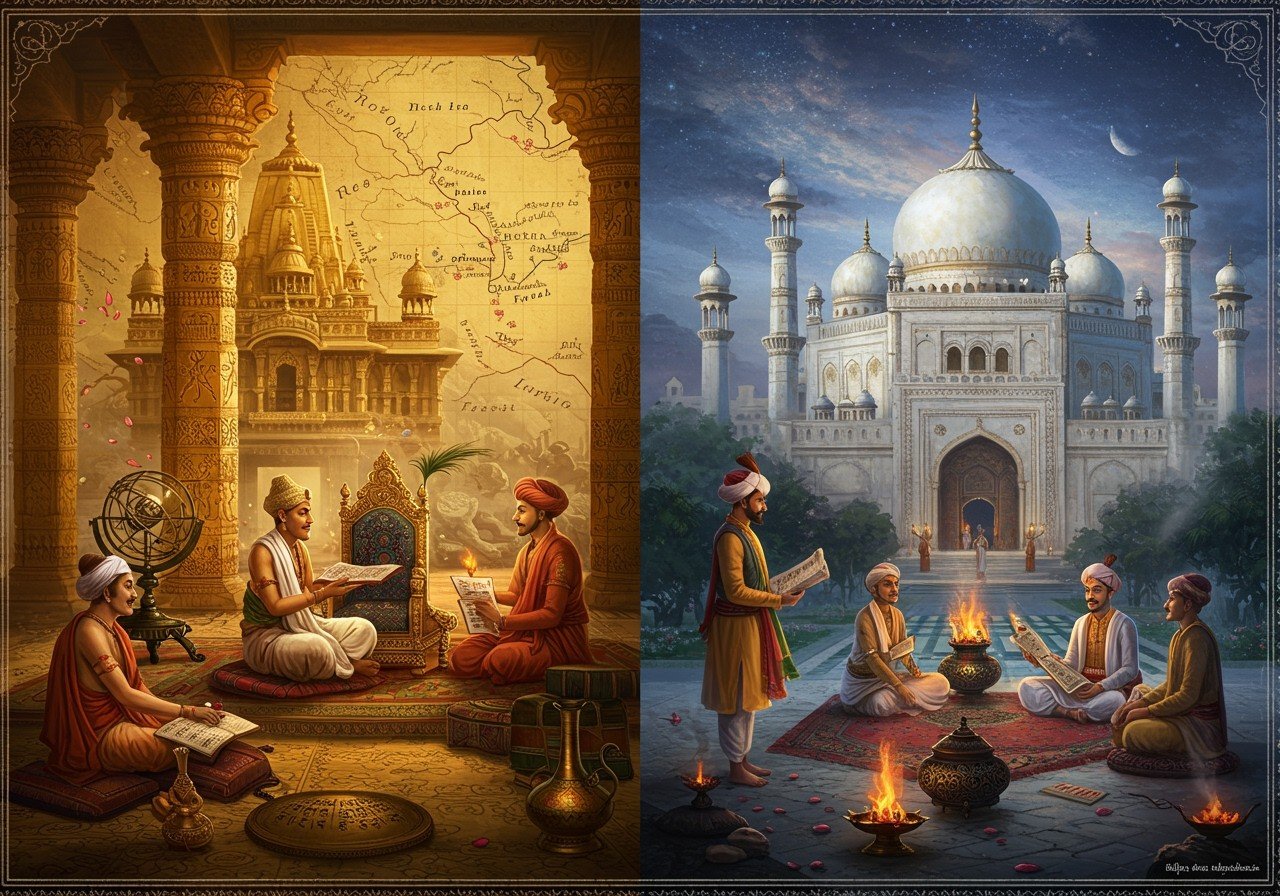
India’s history is a captivating narrative spanning millennia. This article delves into the pivotal periods that shaped India’s identity, focusing on the pre-Mughal, Mughal, and pre-British eras. This exploration is particularly relevant for culturally conscious Indians who appreciate tradition and seek authentic historical insights.
India Before the Mughals
Before the Mughals, India witnessed a vibrant tapestry of civilizations and empires:
- Indus Valley Civilization (c. 3300-1300 BCE): Known for its advanced urban planning, sophisticated drainage systems, and thriving trade networks connecting it with regions like Mesopotamia. Discoveries at Harappa and Mohenjo-daro reveal remarkable insights into their organized urban life.
- Vedic Period (c. 1500-500 BCE): This era witnessed the emergence of the Vedas, sacred texts that form the bedrock of Hinduism. The Vedic Period laid the foundation for Indian philosophical thought, societal structures, and spiritual practices.
- Maurya Empire (322-185 BCE): The reign of Ashoka the Great marked a turning point, with his embrace of Buddhism and promotion of non-violence after the Kalinga War. Ashoka’s edicts emphasized compassion and dharma, influencing governance and social values.
- Gupta Empire (320-550 CE): Often hailed as India’s Golden Age, this period witnessed remarkable advancements in science, art, literature, and mathematics. The works of Aryabhata in astronomy and Kalidasa in literature exemplify the intellectual and artistic flourishing of this era.
- Regional Kingdoms: In South India, the Cholas, Pandyas, and Cheras made significant contributions to art, architecture, and literature. Their magnificent temples, intricate sculptures, and rich literary works stand as testaments to their cultural achievements.
- Foreign Influences: Interactions with the Greeks, Shakas, and Huns brought new ideas and cultural elements, enriching India’s diverse heritage. These encounters led to a fusion of traditions and artistic styles.
- Delhi Sultanate (1206-1526): The rise of the Delhi Sultanate marked the beginning of Islamic rule in India, introducing Persian cultural influences and paving the way for the Mughal Empire. This period saw the development of Indo-Islamic architecture, exemplified by structures like the Qutub Minar.
The Mughal Empire (1526-1858)
The Mughal Empire profoundly impacted India’s history:
- Establishment (1526): Babur founded the Mughal Empire after his victory at the First Battle of Panipat. His memoirs offer valuable insights into his life, conquests, and the early days of the empire.
- Akbar’s Reign (1556-1605): Akbar the Great is renowned for his policies of religious tolerance, administrative reforms, and patronage of the arts. His reign fostered a relatively peaceful and prosperous era.
- Art and Architecture: Under Jahangir and Shah Jahan, Mughal art and architecture reached its zenith. The Taj Mahal, a timeless masterpiece, stands as a testament to this era’s artistic brilliance.
- Aurangzeb’s Reign (1658-1707): Aurangzeb’s rule was marked by territorial expansion but also religious intolerance and internal conflicts, ultimately weakening the empire. His policies had lasting consequences for the political landscape of India.
- Economic Prosperity: The Mughal era saw significant economic growth fueled by extensive trade networks, agricultural innovations, and flourishing craftsmanship. This prosperity contributed to the empire’s grandeur and influence.
- Decline: Internal strife, the rise of regional powers like the Marathas, and the growing influence of European trading companies contributed to the decline of the Mughal Empire.
India Before British Rule
Following the Mughal decline, several regional powers emerged:
- Maratha Empire: Led by Shivaji, the Marathas played a crucial role in resisting Mughal rule and establishing a powerful kingdom. Their military prowess and strategic acumen posed a significant challenge to the declining Mughal Empire.
- Sikh Empire: Maharaja Ranjit Singh consolidated the Sikh Empire in North-Western India, known for its military strength and secular governance. The empire played a key role in shaping the region’s political landscape.
- Deccan Sultanates: The Deccan Sultanates contributed to India’s artistic and cultural heritage, fostering unique architectural styles and literary traditions. Their patronage of the arts enriched the cultural landscape of the region.
- European Trading Companies: The arrival of European trading companies—Portuguese, Dutch, and French—marked a turning point, with initial trade relations eventually leading to political influence and colonization. These interactions had far-reaching consequences for India’s future.
- Economic Landscape: India’s economy during this period was characterized by vibrant trade and industry. Cities like Surat and Madras became major trading hubs, attracting merchants from across the globe.
- Cultural Exchanges: Interactions with European powers led to cultural exchanges, introducing new ideas, technologies, and artistic influences to Indian society.
Preserving India’s Spiritual Heritage with Poojn.in
Poojn.in, India’s largest cultural goods and services store, helps you connect with India’s rich spiritual traditions. We offer a wide selection of authentic puja items, enabling you to engage with practices that have been integral to Indian culture for centuries.
Explore our diverse collection, including:
- Authentic Ritual Items: Pure copper and brass items, handcrafted puja thalis, traditional bells, and sacred threads, all crafted with respect for tradition. Discover our Laddu Gopal Murti collection crafted from astadhatu brass for your devotional practices.
- Worship Materials: Natural dhoop and agarbatti, pure cotton wicks, genuine kumkum and roli, and specialized puja items for Devi worship, ensuring the authenticity of your rituals. Find Mangalam Camphor for your puja needs.
- Sacred Texts and Guides: Sanskrit prayer books with translations, detailed ritual guides, ancient mantras with meanings, and complete puja sets with instructions, enhancing your understanding and practice. Delve deeper into Hindu scriptures with our detailed exploration.
Visit Poojn.in to discover a wide array of traditional puja items that honor India’s rich spiritual heritage. We offer the convenience of modern shopping while preserving the authenticity of ancient practices.
Conclusion
India’s history is a vibrant tapestry woven with diverse threads. From the Indus Valley Civilization to the Mughal Empire and beyond, each era has contributed to the rich cultural legacy we cherish today. Understanding this historical journey deepens our appreciation for tradition and strengthens our connection to our roots.


